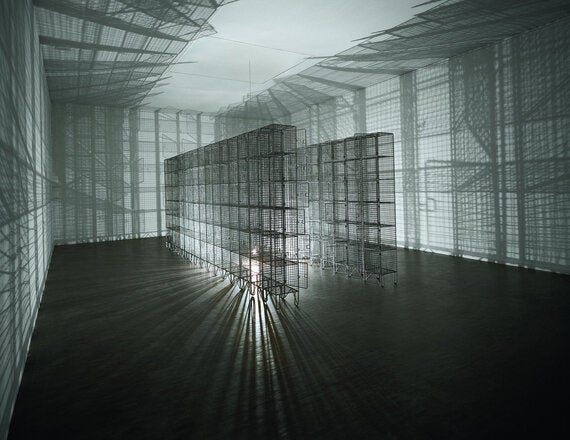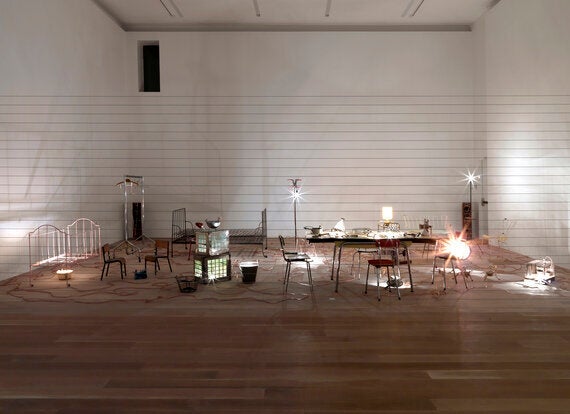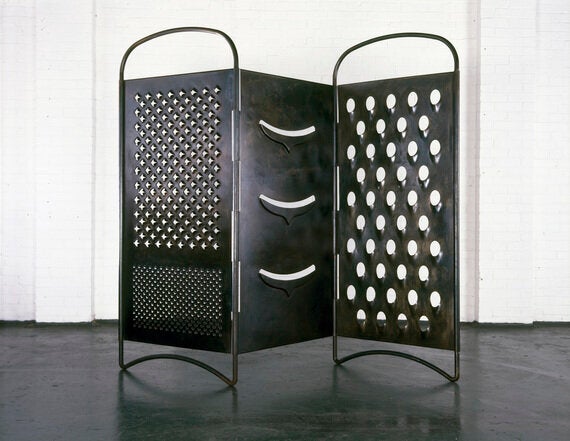
It is one of the great feelings when a show that you've anticipated for so long turns out to be everything you had hoped for.
The new Mona Hatoum show at Tate Modern has pulled together around 100 of her works for this exhibition. And the range of media on display is impressive - from performance to video, sculpture and installation, and photography and works on paper also.
For those unfamiliar with the brilliant Mona Hatoum, she was born in Beirut to a Palestinian family before moving to the UK in 1975. This show at the Tate Modern is the first survey of her work in the UK. And, frankly, it couldn't be more timely.
Mona's works are intense and politically charged. They are infused with challenging, confrontational themes, including politics, violence and oppression. If this show will be the first time you see Mona's works, you will come away understanding why she is considered to be one of the most important artists working today.

Present Tense, 1996, is a great example of Mona's approach. Here, she uses blocks of olive oil soap a traditional Palestinian product from Nabulus, as the foundation for her map of the 1993 Oslo Peace Accord - the outlines created by pressing tiny red glass beads deep into the soap.
And there's Impenetrable, 2009. At first glance, this seems to be an homage to Jesus Rafael Soto's delicate and mesmerising Penetrable, which was made from thin nylon strands. Only on closer inspection, you see Mona's work is made, instead, from barbed wire. Still mesmerising, but threatening too. And overflowing with connotations of conflict and exclusion.
These themes are also evident in Light Sentence, 1992, a work that bristles with containment and oppression. Wire cages fill the room, a stark bare bulb rotates slowly within, its bright glare bouncing off the wire and casting sinister shadows. The title plays on the notion of a lenient prison term but it's apparent that this is anything but.
And, of course, there's Hot Spot III, 2009, the electrifying - and electrified - red globe that has already become the defining image of this exhibition. The title plays on the term for an area of political or civil unrest - a spot, a singular place that is unstable and dangerous. Only here, in Mona's eyes, the whole world is a hot spot. This is a world, hissing with electricity, where every place is red with anger and blood. We are living on a tinderbox.
There's also a glorious saturation of gender politics in some of Mona's works.

Twelve Windows, 2012-13, comprises twelve pieces of traditional Palestinian embroidery. The pieces were each made by women from Inaash - the Association for the Development of Palestinian Camps. This NGO was founded in Lebanon in 1969 to both provide work for Palestinian craftswomen, and in an attempt to preserve traditional skills at risk of extinction from the dispersal of the Palestinian community across the region. Each piece of embroidery represents a different region, which is evocative. But then throw in the tense steel cables used as both barriers and washing lines to display these, and you have a piece that drips with politics.
Similarly in Homebound, 2000. A room has been taken over by a very sparse, almost impoverished, domestic scene. Bare tables and basic chairs share space with empty bed frames and wastepaper bins. But all of these items are linked together by electricity cables, cables that are filled with a charge so powerful that if you were to touch it, it would kill you.
The room hisses with energy. And taught wire barriers keep the audience separate from what could kill them - or do these wires, in fact, represent how women are trapped within the home, unable to leave?

And, add to that, Mona's six foot tall recreations of kitchen utensils nearby - graters and slicers that ominously tower over you, their blades ready to cut - and you have domesticity tilted on its axis to the point where it is lethal. This stuff could kill you.
Mona's works seem to run the full gamut of emotions. Watching Corps étranger, a film of an endoscopic probe's journey through Mona's body, is unsettling to watch. And your heart sinks watching + and -, 1994-2004, where a motor continuously creates and erases patterns in a large box of sand. Creation and destruction playing endlessly on repeat.
Hosting an exhibition with this many installations and large works is a challenge. How do you situate them? And in what order? This may explain why the layout of the show is not chronological - perhaps too difficult to arrange. Shame, as it would have been interesting to witness the development of Mona's style and thinking without having to recreate the chronology of works in my head.
Nevertheless, this is a superb show that, quite literally, hums with energy. It is also one that challenges perceived conventional thought of global society, community, and even what constitutes art itself. If I could, I would take you all there myself. Unfortunately, I can't. But if you can visit - do. This is a show that leaves its mark.
Tate Modern, London to August 21, 2016
Admission £16 (concessions available)
Image Credits:
1. Mona Hatoum, Hot Spot III, 2009. Stainless steel, neon tube. Photo: Agostino Osio, Courtesy Fondazione Querini Stampalia Onlus, Venice ©Mona Hatoum
2. Mona Hatoum, Light Sentence 1992. Galvanised wire mesh lockers, electric motor and light bulb. 198 x 185 x 490. Centre Pompidou, Musée National d'Art Moderne, Paris: Mnam-CCI / Dist RMN-GP. Photo: Philippe Migeat © Mona Hatoum
3. Mona Hatoum, Homebound, 2000. Kitchen utensils, furniture, electrical wire, light bulbs, dimmer unit, amplifier and two speakers. Dimensions variable. Courtesy Rennie Collection, Vancouver © Mona Hatoum.
4. Mona Hatoum, Grater Divide, 2002. Mild steel 204 x 3.5 cm x variable width © Photo Iain Dickens, Courtesy White Cube © Mona Hatoum.